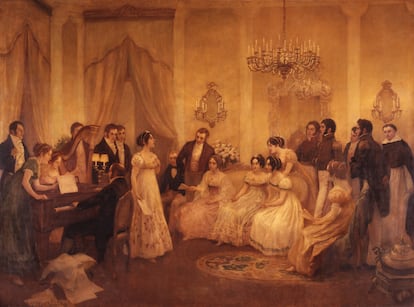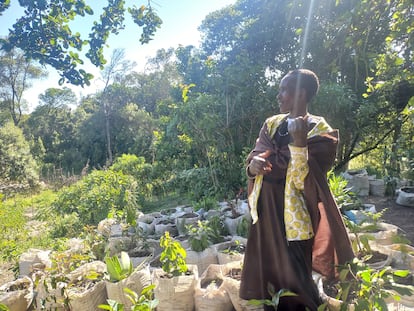The female rebels of the Spanish empire: The women who armed America’s fight for independence
For the past decade, feminist movements in Latin America have been rediscovering and reclaiming the forgotten women revolutionaries who played a role in the Spanish-American wars

In a room at the National Historical Museum of Argentina, located in Buenos Aires’ San Telmo neighborhood, hangs a painting titled Damas Patricias (Patrician Ladies). It is not one of the most important or famous paintings in this museum, a centennial institution that, according to different historians, was built in the same place where the conquistador Pedro de Mendoza founded Buenos Aires in 1536. This piece, by the relatively unknown 19th-century painter José Gerompini, holds historical value for other reasons.
It depicts a pivotal yet often overlooked moment in the nation’s history: a secret meeting of 14 wealthy women from the Viceroyalty of the Río de la Plata, held on the night of May 30, 1812. At this gathering, the women pledged part of their fortunes — donating gold ounces, pesos, reales, and jewelry — to finance the revolution by purchasing rifles for the Liberation Army, which was then fighting against the Spanish royalist forces. Though not known for its artistic quality, Damas Patricias is the only visual representation of this crucial moment in the history of Argentina’s independence.
Damas Patricias pays tribute to 14 Creole women of Spanish descent who rebelled against the Spanish crown. Their financial contributions helped fund the weapons that would ultimately liberate nations like Argentina, Chile, and Peru from the Spanish Empire, which had begun its expansion on October 12, 1492. The names of these women — Tomasa de la Quintana, Remedios de Escalada, Nieves de Escalada, María de la Quintana, María Eugenia de Escalada, Ramona Esquivel y Aldao, María Sánchez de Thompson, Petrona Cordero, Rufina de Orma, Isabel Calvimontes de Agrelo, María de la Encarnación Andonáegui, Magdalena de Castro, Ángela Castelli de Igarzabal, and Carmen Quintanilla de Alvear — were engraved on the rifles they helped purchase, so that upon victory, the women could proclaim: “I armed the arm of this brave man to ensure his glory and our freedom.” Their initiative inspired over 100 other influential women from provinces across the viceroyalty to follow their lead.
“Until I arrived at the museum in 2020, I had no knowledge of Damas Patricias. All the protagonists of the painting are women, which is quite rare in late 19th-century Argentine art. We decided to exhibit it because of its uniqueness and because there is a growing demand to recognize the women who played a significant role in our history,” explains Gabriel di Meglio, director of the National Historical Museum, in a phone interview.
According to Di Meglio, interest in the women involved in the Spanish-American wars of independence gained momentum with the rise of the Ni Una Menos feminist movement that began in Argentina in 2015 and has since spread throughout the region. “Since then, there has been more discussion about them in schools and public spaces,” the historian notes.
Women revolutionaries
Di Meglio was adamant about not relegating Damas Patricias to a separate room or creating a “women’s corner.” She wanted the painting to be integrated with the rest of the museum’s collection, an institution with profound influence on Argentine iconography. Many iconic images found in school textbooks, official portraits, and even on Argentine peso banknotes originate from the National Historical Museum’s art holdings.
“That integration is no simple task, given the significant gender imbalance in the collection,” the historian explains. The museum is filled with portraits and documents of male heroes like José de San Martín, the liberator of Argentina and Chile, a promoter of Peruvian independence, and one of the most pivotal figures of the wars of independence alongside Simón Bolívar. Yet, it preserves few records of the many women who participated in these revolutionary processes across the Americas.
According to Magdalena Candioti, historian and researcher at the National Council for Scientific and Technical Research (Conicet), the study of women’s roles in the wars of independence is “a historiographical field on the rise.” “New approaches have emerged to uncover the stories of these women, which for so long were overshadowed by the lack of sources and a mindset that saw politics and historical relevance as something exclusively tied to men,” Candioti explains. “Until recently, history was androcentric, focused on men who occupied spaces of power and decision-making. New studies reveal that even spaces like war were filled with women,” she continues.
It is now known that women in colonial America defied traditional roles in significant ways. Elite women not only financed the patriotic armies fighting against Spain, but also managed their husbands’ businesses while the men were imprisoned, wove political networks, sheltered allies, denounced traitors, organized public rallies, and penned manifestos. Women from the lower classes played their part by assisting men on the battlefield, fighting themselves, acting as spies and informers, mending uniforms, and even participating in monumental feats like the crossing of the Andes, led by José de San Martín and Bernardo O’Higgins to confront royalist troops in Chile.

At the end of the 19th century, Adolfo Carranza, founder of the National Historical Museum, became one of the first historians to take an interest in what he called the “patrician ladies.” Carranza collected a wealth of material on these elite women of the viceroyalty and, in 1901, published Patricias Argentinas. In this work, he highlighted the role of “the mothers, wives, and daughters of our heroes, and some who stoked the sacred fire during the revolution.” Carranza also condemned “the indifference that has allowed these exalted ladies to fade into obscurity and silence.”
The publication of Patricias Argentinas (Argentine Patricians) popularized the term “patrician” to refer to the country’s upper classes. In ancient Rome, patricians were those descended from the first senators, occupying the highest tier of the social pyramid. In the National Historical Museum of Argentina, another painting pays tribute to female revolutionaries of noble lineage: an oil painting by Pedro Subercaseaux that captures the moment the Argentine National Anthem was sung for the first time in the living room of María Sánchez de Thompson’s house in 1813. The only daughter of one of the wealthiest families of her time, Thompson is regarded as one of the most active female figures in the revolutionary process. She was among the first politically engaged women and a chronicler of the events that shaped Argentina’s foundation as a republic.
The sociologist and historian Dora Barrancos, a prominent figure in Argentine feminism, is not comfortable with the term “patrician.” She considers it an evocative and “very patriarchal” label rooted in historiographic traditions. “From an academic perspective, that term has become outdated. Today, history and popular feminism aims to highlight women of all classes and ethnicities who played significant roles in the independence processes, beyond those from patrician backgrounds,” she explains. “This shift is occurring throughout Latin America,” she adds, citing examples such as Mexican insurgent heroine Manuela Medina, of Indigenous descent, and Chilean spy Agueda Monasterio, who hailed from a middle-class family.
Rediscovered figures
Revolutionary women rediscovered in recent years include Juana Azurduy, the daughter of a mixed-race Bolivian woman and a wealthy white man of Spanish descent, who fought in the wars of independence. In 2015, the Argentine government of Cristina Fernández de Kirchner replaced a monument of Christopher Columbus with one honoring Azurduy. This gesture sparked controversy and discomfort among certain media outlets and conservative sectors of society.
Another recently recognized figure is María Remedios del Valle, an Afro-descendant soldier who served in the war and achieved the rank of sergeant major in the army. Considered a “parda” (a term used in colonial times to refer to descendants of African slaves who mixed with Europeans and Indigenous people), Del Valle earned the nickname “Mother of the Homeland” for her bravery on the battlefield. However, after the war, she faced the harsh reality of poverty and was reduced to begging. Today, every November 8, the National Day of Afro-Argentines is celebrated in her honor. In May of this year, the Central Bank of Argentina issued new 10,000-peso banknotes bearing her image.
Kirchner included the busts of María Remedios del Valle and Juana Azurduy in the Women’s Hall of the Casa Rosada, the seat of government in Argentina. This space was inaugurated in 2009 to honor the heroines of independence. Mauricio Macri, Kirchner’s successor, dismantled the hall, but the government of Alberto Fernández later restored it. In March of this year, coinciding with International Women’s Day, President Javier Milei announced that the Hall of Women would be renamed the Hall of Heroes. “The fact that there is a Hall of Women is perhaps even discriminatory to men,” said Manuel Adorni, the presidential spokesman. Milei’s administration has also dissolved the Ministry of Women and canceled projects and institutions focused on promoting the historical memory of patriotic women.
“Milei’s government does not seem willing to continue with feminist and gender policies aimed at deconstructing this very unequal and androcentric world,” says Candioti. “We are seeing a rollback, but there is a feminist movement from below that cannot be dismantled overnight. I believe there is no turning back,” she concludes. Barranco shares this sentiment. “No war can be sustained without women in the rearguards,” she says. “History has shown us that without women, there is no possibility of common survival.”
Sign up for our weekly newsletter to get more English-language news coverage from EL PAÍS USA Edition
Tu suscripción se está usando en otro dispositivo
¿Quieres añadir otro usuario a tu suscripción?
Si continúas leyendo en este dispositivo, no se podrá leer en el otro.
FlechaTu suscripción se está usando en otro dispositivo y solo puedes acceder a EL PAÍS desde un dispositivo a la vez.
Si quieres compartir tu cuenta, cambia tu suscripción a la modalidad Premium, así podrás añadir otro usuario. Cada uno accederá con su propia cuenta de email, lo que os permitirá personalizar vuestra experiencia en EL PAÍS.
¿Tienes una suscripción de empresa? Accede aquí para contratar más cuentas.
En el caso de no saber quién está usando tu cuenta, te recomendamos cambiar tu contraseña aquí.
Si decides continuar compartiendo tu cuenta, este mensaje se mostrará en tu dispositivo y en el de la otra persona que está usando tu cuenta de forma indefinida, afectando a tu experiencia de lectura. Puedes consultar aquí los términos y condiciones de la suscripción digital.
More information
Archived In
Últimas noticias
Most viewed
- Alain Aspect, Nobel laureate in physics: ‘Einstein was so smart that he would have had to recognize quantum entanglement’
- Mexico’s missing people crisis casts a shadow over World Cup venue
- Why oil has been at the center of Venezuela-US conflicts for decades
- Trump clarifies who is ultimately in charge in Venezuela: ‘Me’
- Mexico seeks to shore up its defenses following US incursion in Venezuela











































